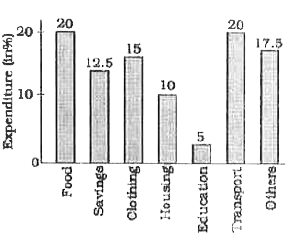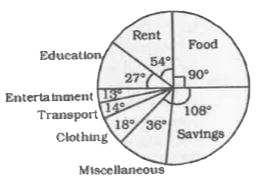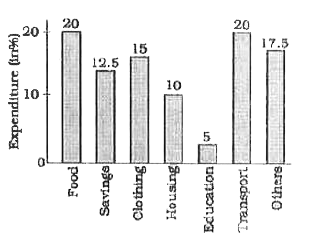The percent of income spent on clothing exceeds that on savings by :
1 12.5 %
2 2.5 %
3 10%
4 22.5 %
Answer : 2. "2.5 % "
Related Solutions
The bar graph given below shows the spending of a family income on various items and savings during 1993. Observe the graph and answer the following questions :

The percent of income spent on clothing exceeds that on savings by :View SolutionA man earns ₹ 2400 and saves ₹ 600, then what percent of his income is spent?
View SolutionMy income is Rs 20000. I spent of my income. When my income increased by then I spent Rs. 5000 more. Find the percent change in my savings.
View SolutionIf saving exceeds investment, then national income will go to _____
View Solutioncan consumption exceed income ? If yes , what is saving then?
View SolutionAmit saves RS 2000 and spent 20%of his income his income is
View SolutionPradeep spends 40 percent of his monthly income on food items and 50 percent of the remaining on cloths and conveyance. He saves one-third of the remaining amount after spending on food. Clothes and conveyance. If he saves Rs. 19,200 every year. What is his monthly income?
View SolutionIn an economy, every time the income rises, 75 percent of the rise in income is spent on consumption. Now suppose in the same economy investment rises by Rs. 750 crore. Calculate : (i) change in income, (ii) change in saving.
View SolutionThe pie chart, given here shows monthly expenses on various heads and savings of the family of Mr. Rao. Study the chart and answer the questions based on it.

The amount spent on food exceeds the total amount spent on education and clothing byView SolutionThe pie chart, given here shows monthly expenses on various heads and savings of the family of Mr. Rao. Study the chart and answer the questions based on it. The amount spent on food exceeds the total amount spent on education and clothing by
View SolutionIf a man earns 2400 and saves 600, what percentage of his income is spent?
View Solutiona person of his income (1)/(3) on portion meals (2)/(5) part rental and (1)/(5) Part is spent on clothes. If his savings are ₹ 400, then what is the total income?
View SolutionThe following pie-chart shows the monthly expenditure of a family on food, clothing, rent, miscellaneous expenses and savings. If the family spends Rs. 825 on clothing, answer the following questions: (i) What is the total monthly income of the family? (ii) What percent of the total income does the family save?
View SolutionIn an economy , of increased income is spent on conumption. If Rs. 4 crores are invested in a Project, find out the increase in income and saving.
View SolutionThe bar graph given below shows the spending of a family income on various items and savings during 1993. Observe the graph and answer the following questions :

The percent of income spent on food is :View SolutionSudha saves 15% of her income. If his expenditure is increased by 20% and his savings is increased by 60%, then by what percent is his income increased?
View SolutionSudha saves 15% of her income. If her expenditure increases by 20% and savings increases by 60% , then by what percent has her income increased?
सुधा अपनी आय का 15% बचत करती है | यदि उसका व्यय 20% से बढ़ जाता है तथा बचत में 60% की वृद्धि हो जाती है, तो उसकी आय में कितने प्रतिशत की वृद्धि हुई है ?View SolutionRaman spends 80% of his income. If their income is increased by 25% and their expenditure is increased by 10%. Then by what percent will their savings increase?
View SolutionWhatever income Rajesh has, he 4:5 Expenditure and saves respectively in the ratio of Rs. whatever amount he spends 40% The amount saved is spent on food and rest on entertainment. 40% balance amount deposited in bank 60% The amount spent by him on entertainment is invested in the share what percent of the amount deposited in the bank?
View SolutionSantosh spends and saves his income in the ratio 8 : 5. He spends of his expenditure on food and of his expenditure on clothes. He deposits of his savings in bank. Money spends by him on clothes is what percent of money deposited in bank.
View Solution
